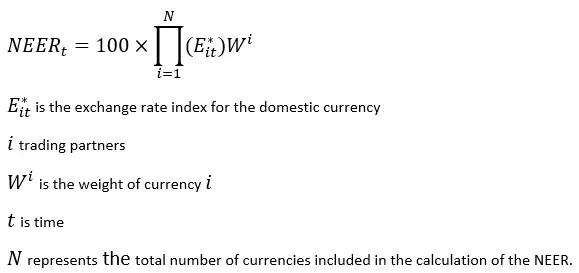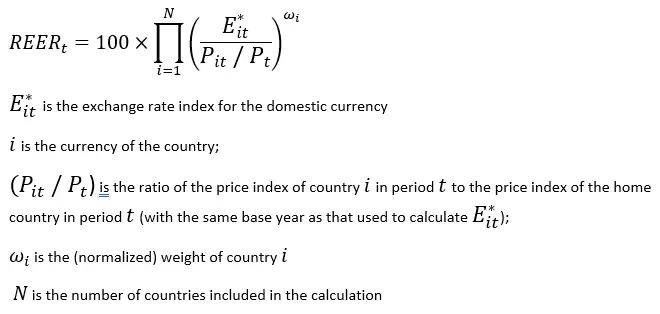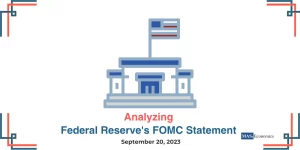Exchange rates play an important role in global economics. They influence the costs of goods, services, and investments across borders and are integral to global trade. Exchange rates affect businesses that export and import goods and services, investors who invest overseas, and consumers who purchase foreign-made products. Exchange rates can profoundly affect a country’s financial health, leading to economic growth or recession. Exchange rate fluctuations can become volatile in times of economic uncertainty or instability – having far-reaching implications across global markets.
What is Exchange Rate
The exchange rate is the relative value of two currencies determined through the interactions among households, firms, and financial institutions in the foreign exchange market, where currency units are bought and sold for international payments.
The exchange rate between two currencies is referred to as the bilateral exchange rate or the exchange rate.
This can be expressed as either the price of the domestic currency against a foreign currency or the price of a foreign currency in terms of the domestic one.

The decision between the two definitions is purely a matter of convention, as the same information is communicated no matter which one is used.
E expresses the external value of the domestic currency in terms of some foreign currency (usually U.S. dollars).
An increase in E implies an appreciation of the domestic currency (or revaluation in the case of a fixed exchange rate regime).
In contrast, a decrease in E implies a depreciation (or devaluation in the case of a fixed exchange rate regime).
Exchange rate indices relative to a base period (t = 0) may be calculated as follows:

What is a Cross Rate
It is the exchange rate between two currencies that do not share a direct market. It is derived from the comparative value of each currency in relation to a third currency, typically known as the “base currency” (U.S. dollar).
The cross rate can be calculated by taking the ratio of the two currencies exchange rates to the base currency or converting one of the currencies into a different form, such as gold or another commodity.
For example, to obtain the euro/yen (cross) exchange rate:

You can see the latest cross rates of different currency pairs from Bloomberg.
It is crucial to differentiate between spot and forward exchange rates.
Spot and Forward Exchange Rates
Spot and forward nominal exchange rates differ in that the former is a rate at which two currencies are exchanged on the spot, while the latter refers to an agreement to exchange two currencies at a set date and rate in the future. Spot rates are based on market conditions; forward rates are calculated from forecast predictions of what the spot rate may be when exchanged in the future.
In reality, the country trades with many countries. To calculate a currency’s strengths and weaknesses against various trading partners,s we need an indices
Nominal Effective Exchange Rate (NEER)
It is a crucial indicator for assessing the strength or weakness of a country’s currency of its trading partners. It measures the average changes in a country’s nominal exchange rate against other currencies over a given period and considers the relative importance of their respective trading partners. NEER is calculated by weighting each bilateral exchange rate with the relative importance of the trading partner in total trade. A higher NEER indicates a stronger currency, and a lower NEER implies a weaker currency.
This can help investors determine when to buy or sell a currency and aid governments in making foreign exchange and international trade policy decisions.
The nominal effective exchange rate is a numerical index that evaluates a country’s currency based on its value relative to those of other countries, as determined by the trading volume of each currency in relation to the others. This differs from the bilateral nominal exchange rate, which only compares two currencies with respect to their specific exchange rate. The NEER considers multiple currencies and their respective values to measure a nation’s currency strength overall.

Another important distinction is between the nominal and real exchange rates. Whereas the nominal exchange rate is the price of one currency in terms of another, the real exchange rate (R) is a measure of the relative price (or cost) of one country’s goods and services relative to those of another when both are expressed in the same currency. It can be expressed as:

Movements in the real exchange rate indicate shifts in the relative cost of different national output baskets, which may result in changes in the demand for these baskets.
The real exchange rate can be computed on a bilateral or multilateral basis.
The real effective exchange rate
The real effective exchange rate (REER) index measures the extent to which the purchasing power of a particular currency has changed over time relative to a group of other countries rather than just one country. The REER is calculated by deflating each component of the NEER index by the associated measure of relative price or cost movements:

Many issues regarding the construction of the nominal effective exchange rate also apply here, with the additional issue of which deflator to use. Any price indices can be used to construct a REER index; however, the different deflators will likely result in different measurements of the evolution of the REER.
Nominal Exchange Rate Vs. Real Exchange Rate
The nominal exchange rate measures the value of one currency relative to another currency, expressed in terms of an equivalent amount of each currency. It is typically measured in terms of the number of units of one currency that can be exchanged for a unit of the other. On the other hand, the real exchange rate goes beyond the nominal exchange rate by adjusting for differences in purchasing power parity (PPP) between countries. It considers changes in prices of both traded and non-traded goods and costs associated with transportation and distribution. This means that real exchange rates indicate relative living standards between countries and provide a more accurate measure than nominal exchange rates.
Exchange rate regimes
We defined above that the exchange rate is the value of one unit of domestic currency when measured against a foreign currency, typically denominated in U.S. dollars. The exchange rate is decided within the foreign exchange market. However, many governments do not rely on market forces alone to find an equilibrium state. Instead, they employ policies that aim to maintain or even control the current level or trajectory of their currency’s exchange rate. This is referred to as the exchange rate regime for each country.
Monetary authorities aim to keep the exchange rate at the desired level by either stepping in to buy or sell foreign currency on the foreign exchange markets or by manipulating domestic interest rates to make financial assets denominated in the domestic currency more or less attractive when compared with foreign assets. This consequently adjusts the demand for domestic currency.
Exchange rate regimes can generally be divided into fixed and flexible categories. In a fixed regime, the monetary authorities are obligated to trade the currency at a set rate. With a flexible exchange rate, the market will decide its value. In reality, numerous versions of exchange rate regimes are available.
The International Monetary Fund (IMF) has devised a system that categorizes exchange rate arrangements according to the flexibility they allow and the presence (or absence) of commitment to a specific exchange rate path.
Exchange arrangements with no separate legal tender
In countries with no separate legal tender, either the currency of another country is exclusively used, or it is a member of a monetary/currency union where all members adopt the same currency. This eliminates the ability of the regulatory body to manage domestic monetary policies independently.
Currency board arrangements
Currency board arrangements are a form of fixed exchange rate regime that requires a country to exchange its domestic currency for a foreign currency at a regular rate. Any new currency issued must be backed by foreign assets, and traditional central banking roles, like monetary control and lender-of-last-resort, are no longer applicable. There is little room for discretionary monetary policy in this arrangement.
Other conventional fixed peg arrangements:
In conventional fixed peg arrangements, a country links its currency to the currency of its major trading partners or financial backers. This creates an exchange rate that can move up to ±1% around a central point or have a 2% margin between its highest and lowest values. Additionally, the monetary authority can intervene in direct (foreign exchange purchase/sale) or indirect ways (such as using interest rates, regulations, and moral suasion) to keep the rate steady. Compared to more restrictive regimes like currency boards, this offers traditional central banking functions flexibility.
Pegged exchange rates within horizontal bands
Exchange rates between two currencies may be set at a fixed rate, with the currency’s value fluctuating by at least ±1% around a central rate. The maximum and minimum values of this exchange rate can differ by more than 2%, while the width of the band allows for a limited degree of monetary policy discretion.
Crawling pegs
A crawling peg is an exchange rate system in which a currency’s value fluctuates within a narrow margin (2%) around a central flat rate that can be adjusted periodically. Depending on the situation, this adjustment may happen in small fixed amounts or be based on factors such as past inflation differentials and inflation targets. This way, it keeps monetary policy restrained, similar to a fixed peg system.
Exchange rates within crawling bands
Exchange rates in crawling bands see a currency’s value fluctuate into a broader margin than 2 percent. The level of flexibility this creates is determined by the width of the band and can vary from symmetric to asymmetric. Upper and lower bounds may sometimes be given without a central preannounced rate. This restraint on monetary policy depends on the width of the band.
Managed floating with no predetermined path for the exchange rate
When opting for managed floating, the central bank does not have a specified target rate or boundaries for the exchange rate. They will instead adjust the rate based on their evaluation of other macroeconomic variables, such as the balance of payments, international reserves, and parallel market developments. Intervention might be explicit or implicit, but no adjustments are guaranteed to be made automatically.
Independently floating
In independent floating, the exchange rate is set by the market. Any official foreign exchange market intervention is focused on controlling how quickly the rate changes rather than setting a specific level for it.
Purchasing power parity
Purchasing power parity (PPP) is an economic theory that says the value of two currencies should be determined by comparing how much different items cost each country. It looks at a basket of goods and services to decide how much something costs in each currency so that we can compare them fairly.
It is a valuable reference point for evaluating exchange rate and inflation trends. It dictates that the nominal exchange rate between two currencies should reflect the respective purchasing power of those currencies, as represented by their respective national price levels.

When comparing the purchasing power of domestic currencies abroad to what it is domestically, if the exchange rate falls below the expected rate of PPP, then it will be weaker when abroad. Variations in currency purchasing power across countries can be attributed to differences in prices of goods and services, consumer preference, and price index methodology. If these factors remain constant over time, even if PPP does not hold, changes in exchange rates still equate to variations between foreign and domestic inflation.

When comparing the value of buying goods in different countries, sometimes it takes more of one country’s money to buy the same thing in another country. However, over a longer period of time, the amount of money needed to buy the same things will usually become equal because economic forces work to even out the differences. For this reason, it is essential to look at relative purchasing power when predicting future price fluctuations and changes in exchange rates.
Conclusion
Exchange rates are a vital factor in determining the relative value of different currencies. Exchange rate regimes such as crawling pegs and managed floating can help limit currency fluctuations while providing some degree of flexibility to monetary policymakers. The Nominal Effective Exchange Rate is an index that measures this by taking into account all significant currencies against which the base currency trades. Similarly, the Real effective exchange rate considers inflationary factors when calculating NEERs. Lastly, Purchasing power parity provides another way to compare two countries’ currencies by looking at how much it costs for goods or services across both locations over time. Allowing policymakers to make more informed decisions about future price changes and movements in global trade.




